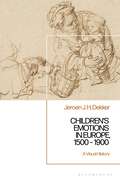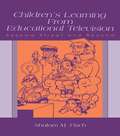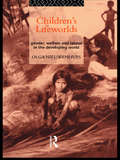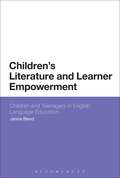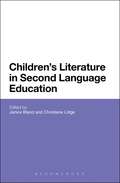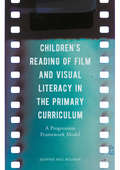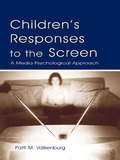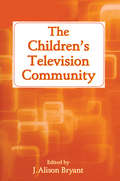- Table View
- List View
Children’s Creative Inquiry in STEM (Sociocultural Explorations of Science Education #25)
by Karen Janette Murcia Coral Campbell Mathilda Marie Joubert Sinead WilsonThis edited volume brings together international research that explores children’s creativity in STEM inquiry. It takes the position that creativity is relevant in all aspects of life and is essential for adaptable and innovative thinking. The research informed content of the book, highlights both challenges and opportunities for growing children’s creativity. The book focuses on fostering children’s creativity and natural curiosity in the world around them through STEM inquiry. Through STEM inquiry, children are learning through a cross- disciplinary approach where they apply concepts from multiple fields as they are thinking creatively, problem solving and constructing solutions. Educators play a critical role in encouraging children’s creativity by modelling creativity, providing creative projects for children and importantly, establishing rich culturally connected environments where children have the resources, conditions and opportunities for acting and thinking creatively. The book provides a lens for looking at children’s creativity in a range of different cultural settings. It offers insight and guidance to future research and will build educators’ capacity for developing children’s creative practices.
Children's Creative Music-Making with Reflexive Interactive Technology: Adventures in improvising and composing (Routledge Research in Education)
by Victoria Rowe Angeliki Triantafyllaki Francois PachetChildren's Creative Music-Making with Reflexive Interactive Technology discusses pioneering experiments conducted with young children using a new generation of music software for improvising and composing. Using artificial intelligence techniques, this software captures the children’s musical style and interactively reflects it in its responses. The book describes the potential of these applications to enhance children’s agency and musical identity by reflecting players’ musical inputs, storing and creating variations on them. Set in the broader context of current music education research, it addresses the benefits and challenges of incorporating music technologies in primary and pre-school education. It is comprised of six main chapters, which cover the creation of children's own music and their musical selves, critical thinking skills and learner agency, musical language development, and emotional intent during creative music-making. The authors provide a range of straight-forward techniques and strategies, which challenge conceptions of ‘difficult-to-use music technologies’ in formal music education. These are supported by an informative collection of practitioner vignettes written by teachers who have used the software in their classrooms. Not only are the teachers’ voices heard here, but also those of children as they discover some of the creative possibilities of music making. The book also provides free access to a companion website with teacher forums and a large bank of activities to explore. A toolkit serves as a database of the teaching activities in which MIROR applications have been used and provides a set of useful ideas regarding its future use in a variety of settings. This book demonstrates that music applications based on artificial intelligence techniques can make an important contribution to music education within primary and pre-school education. It will be of key interest to academics, researchers and postgraduate students in the fields of music education, music technology, early years and primary education, teaching and learning, and teacher educators. It will also serve as an important point of reference for Early Years and Primary practitioners.
Children's Creative Music-Making with Reflexive Interactive Technology: Adventures in improvising and composing (Routledge Research in Education)
by Victoria Rowe Angeliki Triantafyllaki Francois PachetChildren's Creative Music-Making with Reflexive Interactive Technology discusses pioneering experiments conducted with young children using a new generation of music software for improvising and composing. Using artificial intelligence techniques, this software captures the children’s musical style and interactively reflects it in its responses. The book describes the potential of these applications to enhance children’s agency and musical identity by reflecting players’ musical inputs, storing and creating variations on them. Set in the broader context of current music education research, it addresses the benefits and challenges of incorporating music technologies in primary and pre-school education. It is comprised of six main chapters, which cover the creation of children's own music and their musical selves, critical thinking skills and learner agency, musical language development, and emotional intent during creative music-making. The authors provide a range of straight-forward techniques and strategies, which challenge conceptions of ‘difficult-to-use music technologies’ in formal music education. These are supported by an informative collection of practitioner vignettes written by teachers who have used the software in their classrooms. Not only are the teachers’ voices heard here, but also those of children as they discover some of the creative possibilities of music making. The book also provides free access to a companion website with teacher forums and a large bank of activities to explore. A toolkit serves as a database of the teaching activities in which MIROR applications have been used and provides a set of useful ideas regarding its future use in a variety of settings. This book demonstrates that music applications based on artificial intelligence techniques can make an important contribution to music education within primary and pre-school education. It will be of key interest to academics, researchers and postgraduate students in the fields of music education, music technology, early years and primary education, teaching and learning, and teacher educators. It will also serve as an important point of reference for Early Years and Primary practitioners.
Children’s Emotions in Europe, 1500 – 1900: A Visual History
by Professor Jeroen J. DekkerThis book gives you the historical sensation of coming face to face with the bodily expression and regulation of children's emotions over time. The study does this by encouraging you to look through the eyes of well-known artists, like Albrecht Dürer, Domenico Ghirlandaio, Jan Steen, Antony van Dyck, Rembrandt, and Titian in early modern Europe, and Jean-Baptiste Siméon Chardin, Thomas Lawrence,Jean-Honoré Fragonard, Philipp Otto Runge, Willem Bartel van der Kooi, Paul Gauguin, Auguste Renoir, and Jozef Israëls in the late 18th and 19th centuries. These sources are supplemented by works from less-famous artists, as well as popular emblem books, child-advice manuals, observations from the emerging child sciences, and personal documents. Jeroen Dekker observes children's emotions mainly in the child's world and in the domestic emotional space, and connects them with history's ongoing, underlying discourse on education and the emotions. This discourse was developed by theologians, philosophers, and moralists like Augustine, Aquinas, Erasmus, Descartes, Jacob Cats, John Locke and Jean-Jacques Rousseau, by Romantic educationalists like Friedrich Fröbel and Ellen Key, and by scientists like Charles Darwin and William James who emphasized the biological instead of the moral fundament of children's emotions. The story of children's emotions is told in the context of cultural movements like the Renaissance, Humanism, the Reformation, the Enlightenment, Romanticism, and the starting Age of Child Science. Children's Emotions in Europe, 1500 – 1900 crucially highlights the continuous co-existence of regulation-oriented and child-oriented educational views on children's emotions.
Children’s Emotions in Europe, 1500 – 1900: A Visual History
by Professor Jeroen J. DekkerThis book gives you the historical sensation of coming face to face with the bodily expression and regulation of children's emotions over time. The study does this by encouraging you to look through the eyes of well-known artists, like Albrecht Dürer, Domenico Ghirlandaio, Jan Steen, Antony van Dyck, Rembrandt, and Titian in early modern Europe, and Jean-Baptiste Siméon Chardin, Thomas Lawrence,Jean-Honoré Fragonard, Philipp Otto Runge, Willem Bartel van der Kooi, Paul Gauguin, Auguste Renoir, and Jozef Israëls in the late 18th and 19th centuries. These sources are supplemented by works from less-famous artists, as well as popular emblem books, child-advice manuals, observations from the emerging child sciences, and personal documents. Jeroen Dekker observes children's emotions mainly in the child's world and in the domestic emotional space, and connects them with history's ongoing, underlying discourse on education and the emotions. This discourse was developed by theologians, philosophers, and moralists like Augustine, Aquinas, Erasmus, Descartes, Jacob Cats, John Locke and Jean-Jacques Rousseau, by Romantic educationalists like Friedrich Fröbel and Ellen Key, and by scientists like Charles Darwin and William James who emphasized the biological instead of the moral fundament of children's emotions. The story of children's emotions is told in the context of cultural movements like the Renaissance, Humanism, the Reformation, the Enlightenment, Romanticism, and the starting Age of Child Science. Children's Emotions in Europe, 1500 – 1900 crucially highlights the continuous co-existence of regulation-oriented and child-oriented educational views on children's emotions.
The Children's Film Foundation: History and Legacy
by Robert ShailFrom the 1950s to the 1980s the Children's Film Foundation made films for Saturday morning cinema clubs across the UK - entertaining and educating generations of British children. This first history of this much-loved organisation provides an overview of the CFF's films, interviews with key backstage personnel, and memories of audience members.
Children's Learning From Educational Television: Sesame Street and Beyond
by Shalom M. FischAt its best, educational television can provide children with enormous opportunities and can serve as a window to new experiences, enrich academic knowledge, enhance attitudes and motivation, and nurture social skills. This volume documents the impact of educational television in a variety of subject areas and proposes mechanisms to explain its effects. Drawing from a wide variety of research spanning several disciplines, author Shalom M. Fisch analyzes the literature on the impact of educational resources. He focuses on television programs designed for children rather than for adults, although adult literature is included when it is particularly relevant. In addition, much of the discussion concerns the effects of unaided viewing by children, rather than viewing in the context of adult-led follow-up activities. The role of parent-child co-viewing and issues relevant to the use of television in school or child care also receives consideration. This volume is intended to make the disparate literature on educational television's impact more accessible, by bringing it together into a centralized resource. To that end, the volume draws together empirical data on the impact of educational television programs--both academic and prosocial--on children's knowledge, skills, attitudes, and behavior. In addition to its emphasis on positive effects, this volume addresses a gap in the existing research literature regarding children's learning from exposure to educational television. Acknowledging that little theoretical work has been done to explain why or how these effects occur, Fisch takes a step toward correcting this situation by proposing theoretical models to explore aspects of the mental processing that underlies children's learning from educational television. With its unique perspective on children's educational television and comprehensive approach to studying the topic, this volume is required reading for scholars, researchers, and students working in the area of children and television. It offers crucial insights to scholars in developmental psychology, family studies, educational psychology, and related areas.
Children's Learning From Educational Television: Sesame Street and Beyond
by Shalom M. FischAt its best, educational television can provide children with enormous opportunities and can serve as a window to new experiences, enrich academic knowledge, enhance attitudes and motivation, and nurture social skills. This volume documents the impact of educational television in a variety of subject areas and proposes mechanisms to explain its effects. Drawing from a wide variety of research spanning several disciplines, author Shalom M. Fisch analyzes the literature on the impact of educational resources. He focuses on television programs designed for children rather than for adults, although adult literature is included when it is particularly relevant. In addition, much of the discussion concerns the effects of unaided viewing by children, rather than viewing in the context of adult-led follow-up activities. The role of parent-child co-viewing and issues relevant to the use of television in school or child care also receives consideration. This volume is intended to make the disparate literature on educational television's impact more accessible, by bringing it together into a centralized resource. To that end, the volume draws together empirical data on the impact of educational television programs--both academic and prosocial--on children's knowledge, skills, attitudes, and behavior. In addition to its emphasis on positive effects, this volume addresses a gap in the existing research literature regarding children's learning from exposure to educational television. Acknowledging that little theoretical work has been done to explain why or how these effects occur, Fisch takes a step toward correcting this situation by proposing theoretical models to explore aspects of the mental processing that underlies children's learning from educational television. With its unique perspective on children's educational television and comprehensive approach to studying the topic, this volume is required reading for scholars, researchers, and students working in the area of children and television. It offers crucial insights to scholars in developmental psychology, family studies, educational psychology, and related areas.
Children's Lifeworlds: Gender, Welfare and Labour in the Developing World
by Olga NieuwenhuysChildren's Lifeworlds examines how working children face the challenge of having to combine work with school in Kerala. Moving beyond the usual concern with child labour and welfare to a critical assessment of the daily work routine of children, this book questions how class and kinship, gender and household organization, state ideology and education influence and conceal the lives of children in developing countries. Presenting an extraordinarily sympathetic and detailed case study of boys' and girls' work routine in a south Indian village, this book shows children creating the visibility of their work. The combination of personal experience, quantitative data and in-depth anthropological methods, sheds light on the world of those who, though they hold the future, have been left in the dark.
Children's Lifeworlds: Gender, Welfare and Labour in the Developing World
by Olga NieuwenhuysChildren's Lifeworlds examines how working children face the challenge of having to combine work with school in Kerala. Moving beyond the usual concern with child labour and welfare to a critical assessment of the daily work routine of children, this book questions how class and kinship, gender and household organization, state ideology and education influence and conceal the lives of children in developing countries. Presenting an extraordinarily sympathetic and detailed case study of boys' and girls' work routine in a south Indian village, this book shows children creating the visibility of their work. The combination of personal experience, quantitative data and in-depth anthropological methods, sheds light on the world of those who, though they hold the future, have been left in the dark.
Children's Literature and Learner Empowerment: Children and Teenagers in English Language Education
by Janice BlandChildren's literature can be a powerful way to encourage and empower EFL students but is less commonly used in the classroom than adult literature. This text provides a comprehensive introduction to children's and young adult literature in EFL teaching. It demonstrates the complexity of children's literature and how it can encourage an active community of second language readers: with multilayered picturebooks, fairy tales, graphic novels and radical young adult fiction. It examines the opportunities of children's literature in EFL teacher education, including: the intertexuality of children's literature as a gate-opener for canonised adult literature; the rich patterning of children's literature supporting Creative Writing; the potential of interactive drama projects. Close readings of texts at the centre of contemporary literary scholarship, yet largely unknown in the EFL world, provide an invaluable guide for teacher educators and student teachers, including works by David Almond, Anthony Browne, Philip Pullman and J.K.Rowling. Introducing a range of genres and their significance for EFL teaching, this study makes an important new approach accessible for EFL teachers, student teachers and teacher educators.
Children's Literature and Learner Empowerment: Children and Teenagers in English Language Education
by Janice BlandChildren's literature can be a powerful way to encourage and empower EFL students but is less commonly used in the classroom than adult literature. This text provides a comprehensive introduction to children's and young adult literature in EFL teaching. It demonstrates the complexity of children's literature and how it can encourage an active community of second language readers: with multilayered picturebooks, fairy tales, graphic novels and radical young adult fiction. It examines the opportunities of children's literature in EFL teacher education, including: the intertexuality of children's literature as a gate-opener for canonised adult literature; the rich patterning of children's literature supporting Creative Writing; the potential of interactive drama projects. Close readings of texts at the centre of contemporary literary scholarship, yet largely unknown in the EFL world, provide an invaluable guide for teacher educators and student teachers, including works by David Almond, Anthony Browne, Philip Pullman and J.K.Rowling. Introducing a range of genres and their significance for EFL teaching, this study makes an important new approach accessible for EFL teachers, student teachers and teacher educators.
Children's Literature: Classic Texts and Contemporary Trends
by Heather Montgomery Nicola J. WatsonChildren's Literature: Classic Texts and Contemporary Trends provides students with high quality critical material on a selection of important classic and contemporary children's books. From Louisa May Alcott's Little Women to J. K. Rowling's Harry Potter and the Philosopher's Stone to Melvin Burgess's Junk, each has been selected because they still find a favoured place on the bookshelves of today's children and because they are widely studied on university courses. These case studies explore children's literature across a variety of genres and ages, bringing together lively and accessible scholarly essays by leading scholars, some reprinted and others newly commissioned. The collection is supported by detailed introductory material, suggestions for further reading and a colour plate section reproducing covers and illustrations.
Children's Literature in Second Language Education
by Janice Bland Christiane LütgeBringing together leading scholars and teacher educators from across the world, from Europe and the USA to Asia, this book presents the latest research and new perspectives into the uses of children's literature in second language teaching for children and young adults. Children's Literature in Second Language Education covers such topics as extensive reading, creative writing in the language classroom, the use of picturebooks and graphic novels in second language teaching and the potential of children's literature in promoting intercultural education. The focus throughout the book is on creative approaches to language teaching, from early years through to young adult learners, making this book an essential read for those studying or embarking on second language teaching at all levels.
Children's Literature in Second Language Education
by Janice Bland Christiane LütgeBringing together leading scholars and teacher educators from across the world, from Europe and the USA to Asia, this book presents the latest research and new perspectives into the uses of children's literature in second language teaching for children and young adults. Children's Literature in Second Language Education covers such topics as extensive reading, creative writing in the language classroom, the use of picturebooks and graphic novels in second language teaching and the potential of children's literature in promoting intercultural education. The focus throughout the book is on creative approaches to language teaching, from early years through to young adult learners, making this book an essential read for those studying or embarking on second language teaching at all levels.
Children's Picturebooks: The Art of Visual Storytelling
by Martin Salisbury Morag StylesChildren’s picturebooks are the very first books we encounter, and they form an important, constantly evolving, and dynamic sector of the publishing world. But what does it take to create a successful picturebook for children? In seven chapters, this book covers the key stages of conceiving a narrative, creating a visual language and developing storyboards and design of a picturebook. The book includes interviews with leading children’s picturebook illustrators, as well as case studies of their work. The picturebooks and artists featured hail from Australia, Belgium, Cuba, France, Germany, Hungary, Ireland, Italy, Japan, Norway, Poland, Portugal, Russia, Singapore, South Korea, Spain, Taiwan, the UK and the USA.In this publication, Martin Salisbury and Morag Styles introduce us to the world of children’s picturebooks, providing a solid background to the industry while exploring the key concepts and practices that have gone into the creation of successful picturebooks.
Children's Picturebooks Second Edition: The Art of Visual Storytelling
by Martin Salisbury Morag StylesChildren’s picturebooks are the very first books we encounter and play a major role in introducing us to both art and language. But what does it take to create a successful picturebook for children? This revised edition of a bestselling title carries invaluable insight into a highly productive, dynamic sector of the publishing world. Featuring interviews with leading illustrators and publishers from across the world, it remains essential reading for students and aspiring children’s book illustrators and writers.
Children's Reading of Film and Visual Literacy in the Primary Curriculum: A Progression Framework Model
by Jeannie Hill BulmanThis book draws on a longitudinal study which highlights the beneficial impact of film in the primary curriculum. It provides detailed accounts of both the reading process as understood within the field of literacy education, and of film theory as it relates to issues such as narration, genre and audience. The book focuses on a small cohort of children to explore how progression in reading film develops throughout a child’s time in Key Stage 2; it also examines how the skills and understanding required to read film can support the reading of print, and vice versa, in an ‘asset model’ approach. Since children’s progression in reading film is found to be not necessarily age-related, but rather built on a period of experience and opportunity to read and/or create moving image media, Bulman clearly illustrates the importance of the inclusion of film in the primary curriculum. The book provides an accessible study to a large audience of primary teachers and practitioners, and will be a valuable resource for students and researchers in the fields of education, English and media studies.
Children's Reading of Film and Visual Literacy in the Primary Curriculum: A Progression Framework Model
by Jeannie Hill BulmanThis book draws on a longitudinal study which highlights the beneficial impact of film in the primary curriculum. It provides detailed accounts of both the reading process as understood within the field of literacy education, and of film theory as it relates to issues such as narration, genre and audience. The book focuses on a small cohort of children to explore how progression in reading film develops throughout a child’s time in Key Stage 2; it also examines how the skills and understanding required to read film can support the reading of print, and vice versa, in an ‘asset model’ approach. Since children’s progression in reading film is found to be not necessarily age-related, but rather built on a period of experience and opportunity to read and/or create moving image media, Bulman clearly illustrates the importance of the inclusion of film in the primary curriculum. The book provides an accessible study to a large audience of primary teachers and practitioners, and will be a valuable resource for students and researchers in the fields of education, English and media studies.
Children's Responses to the Screen: A Media Psychological Approach (Routledge Communication Series)
by Patti M. ValkenburgThe past several decades have witnessed thousands of studies into children and the media. Yet, much academic research is still in its infancy when it comes to our knowledge about the uses, preferences, and effects of different media. This distinctive volume moves the field forward in this regard, with its insights into the latest theories and research on children and the media. Author Patti M. Valkenburg explores "screen" media (i.e., television, films, video and computer games, and the Internet), and focuses her study on the most fundamental topics in the study of children and the media. In each chapter, Valkenburg examines an essential topic on children and the media: the effect of media violence, children's emotional reactions to news and entertainment, the intended and unintended effects of advertising, and the uses and effects of computer games and the Internet. She has structured the chapters to provide an overview of existing theories and research on a particular topic, and supplements the work of others with her own ground-breaking research findings. She provides a careful and even-handed treatment of research in children's media, and includes current and noteworthy studies. As a resource for study in children and media and media psychology, this volume provides a timely and thorough examination of the state of theory and research. It will serve as a valuable reference for scholars and as an engaging text for advanced students.
Children's Responses to the Screen: A Media Psychological Approach (Routledge Communication Series)
by Patti M. ValkenburgThe past several decades have witnessed thousands of studies into children and the media. Yet, much academic research is still in its infancy when it comes to our knowledge about the uses, preferences, and effects of different media. This distinctive volume moves the field forward in this regard, with its insights into the latest theories and research on children and the media. Author Patti M. Valkenburg explores "screen" media (i.e., television, films, video and computer games, and the Internet), and focuses her study on the most fundamental topics in the study of children and the media. In each chapter, Valkenburg examines an essential topic on children and the media: the effect of media violence, children's emotional reactions to news and entertainment, the intended and unintended effects of advertising, and the uses and effects of computer games and the Internet. She has structured the chapters to provide an overview of existing theories and research on a particular topic, and supplements the work of others with her own ground-breaking research findings. She provides a careful and even-handed treatment of research in children's media, and includes current and noteworthy studies. As a resource for study in children and media and media psychology, this volume provides a timely and thorough examination of the state of theory and research. It will serve as a valuable reference for scholars and as an engaging text for advanced students.
Children's Spaces
by Mark DudekThis collection of essays is concerned with the experiences children have within the supervised worlds they inhabit, as well as with architecture and landscape architecture.International examples of innovative childcare practice are illustrated together with the design processes which informed their development. The emphasis here is on new and experimental childcare projects which set-out to reassert the rights of children to participate in a complex multi-faceted world, which is no longer available to them, unless under adult supervision. Research supports in depth recommendations regarding the ideal children's environment, across a range of contexts and dimensions. Until recent times, the needs of children within the urban environment were largely ignored. There is little tradition and no broadly agreed contemporary architectural or landscape theory as to how children should be provided for, beyond a limited functional agenda. There is a sense that architecture for childhood is not taken seriously; it is either whimsical and ephemeral or largely designed for adults, an adjunct to the more important business of adult needs and aspirations. Yet children access much of their education and development through play and social interaction with their childhood counterparts. The spaces in and around children"s daycare centres, schools, supervised parks and other dedicated children"s environments are the subject of this collection. As more and more purpose designed buildings and gardens for children are opened, the need to listen to children and their carers is becoming more aparant. Mark Dudek gathers together a number of internationally recognized experts in the field of childcare environments to write about different aspects of the landscape. They have been chosen in particular because of their background in enquiring, research orientated work, both theoretical and practical. They listen to and watch children.Contributors have considered the child"s environment as one which is secure and controlled yet offers additional environmental dimensions which extend developmental possibilities. Children often spend a great deal of time in daycare facilties and schools, as parents are absorbed in their own work and leisure activities. This places an emphasis on architects and planners to consider the needs of children in great detail. As such, the children"s environment must be conceived of as a rich, complex place; a "world within a world".We use the word LANDSCAPE in recognition that children do not differentiate between the inside and the outside, private and public; every part of their perception is open to stimulation by a stimulating environment.
Children's Spaces
by Mark DudekThis collection of essays is concerned with the experiences children have within the supervised worlds they inhabit, as well as with architecture and landscape architecture.International examples of innovative childcare practice are illustrated together with the design processes which informed their development. The emphasis here is on new and experimental childcare projects which set-out to reassert the rights of children to participate in a complex multi-faceted world, which is no longer available to them, unless under adult supervision. Research supports in depth recommendations regarding the ideal children's environment, across a range of contexts and dimensions. Until recent times, the needs of children within the urban environment were largely ignored. There is little tradition and no broadly agreed contemporary architectural or landscape theory as to how children should be provided for, beyond a limited functional agenda. There is a sense that architecture for childhood is not taken seriously; it is either whimsical and ephemeral or largely designed for adults, an adjunct to the more important business of adult needs and aspirations. Yet children access much of their education and development through play and social interaction with their childhood counterparts. The spaces in and around children"s daycare centres, schools, supervised parks and other dedicated children"s environments are the subject of this collection. As more and more purpose designed buildings and gardens for children are opened, the need to listen to children and their carers is becoming more aparant. Mark Dudek gathers together a number of internationally recognized experts in the field of childcare environments to write about different aspects of the landscape. They have been chosen in particular because of their background in enquiring, research orientated work, both theoretical and practical. They listen to and watch children.Contributors have considered the child"s environment as one which is secure and controlled yet offers additional environmental dimensions which extend developmental possibilities. Children often spend a great deal of time in daycare facilties and schools, as parents are absorbed in their own work and leisure activities. This places an emphasis on architects and planners to consider the needs of children in great detail. As such, the children"s environment must be conceived of as a rich, complex place; a "world within a world".We use the word LANDSCAPE in recognition that children do not differentiate between the inside and the outside, private and public; every part of their perception is open to stimulation by a stimulating environment.
Children's Spatialities: Embodiment, Emotion and Agency (Studies in Childhood and Youth)
by Julie Seymour Abigail Hackett Lisa ProcterDrawing from a wide range of disciplines, including anthropology, sociology, architecture and geography, and international contributors, this volume offers both students and scholars with an interest in the interdisciplinary study of childhood a range of ways of thinking spatially about children's lives.
The Children's Television Community (Routledge Communication Series)
by J. Alison BryantThe Children’s Television Community presents a cutting-edge analysis of the children’s television community—the organizations, major players, and approaches to programming—and gives an overview of the history, current state, and future of children’s programming. Leading children’s television professionals and distinguished academicians come together in this volume to take a distinctive behind-the-scenes look at how children’s television is created, programmed, and sold. This thought-provoking work emphasizes the various actors whose creative, financial, political, and critical input go into children’s television, and addresses advocacy for children’s television from multiple approaches. By blending these diverse perspectives, editor J. Alison Bryant offers readers a comprehensive picture of children’s television. Highlights include:* a community level approach to understanding children’s television;* perspectives from colleagues in various aspects of the media industry; and* an eye-opening analysis of how decision-making affects what children are exposed to through television. The Children’s Television Community is highly informative for educators, industry professionals, and practitioners in media, developmental psychology, and education.


